Anshuman Tripathi
Clustering and Mining Accented Speech for Inclusive and Fair Speech Recognition
Aug 05, 2024Abstract:Modern automatic speech recognition (ASR) systems are typically trained on more than tens of thousands hours of speech data, which is one of the main factors for their great success. However, the distribution of such data is typically biased towards common accents or typical speech patterns. As a result, those systems often poorly perform on atypical accented speech. In this paper, we present accent clustering and mining schemes for fair speech recognition systems which can perform equally well on under-represented accented speech. For accent recognition, we applied three schemes to overcome limited size of supervised accent data: supervised or unsupervised pre-training, distributionally robust optimization (DRO) and unsupervised clustering. Three schemes can significantly improve the accent recognition model especially for unbalanced and small accented speech. Fine-tuning ASR on the mined Indian accent speech using the proposed supervised or unsupervised clustering schemes showed 10.0% and 5.3% relative improvements compared to fine-tuning on the randomly sampled speech, respectively.
Contrastive Siamese Network for Semi-supervised Speech Recognition
May 27, 2022
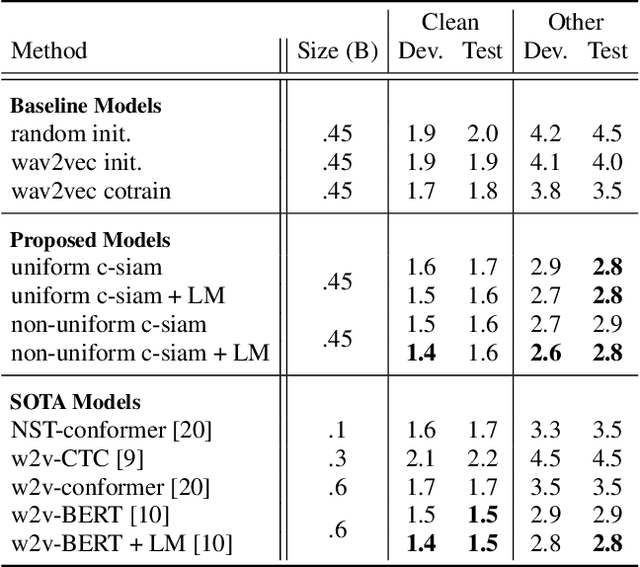
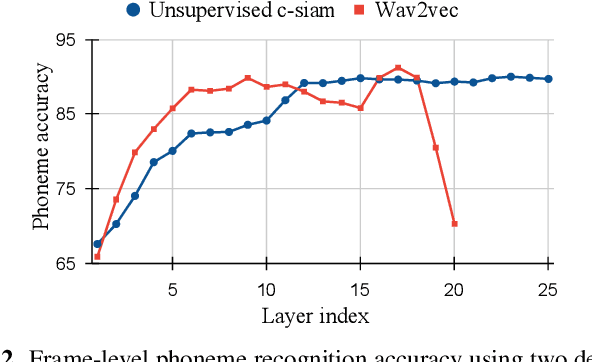
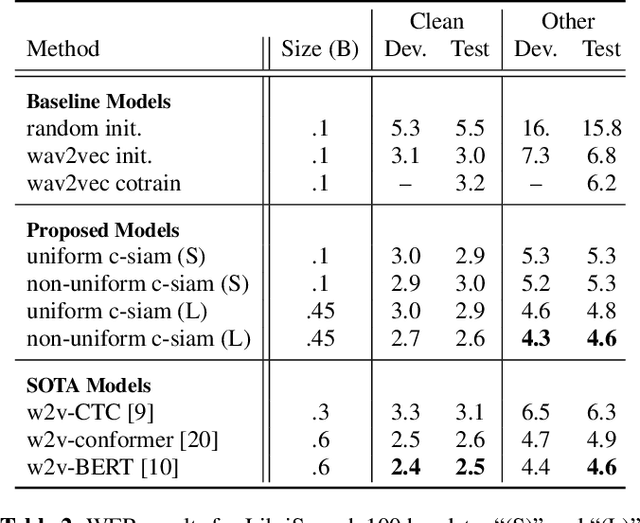
Abstract:This paper introduces contrastive siamese (c-siam) network, an architecture for leveraging unlabeled acoustic data in speech recognition. c-siam is the first network that extracts high-level linguistic information from speech by matching outputs of two identical transformer encoders. It contains augmented and target branches which are trained by: (1) masking inputs and matching outputs with a contrastive loss, (2) incorporating a stop gradient operation on the target branch, (3) using an extra learnable transformation on the augmented branch, (4) introducing new temporal augment functions to prevent the shortcut learning problem. We use the Libri-light 60k unsupervised data and the LibriSpeech 100hrs/960hrs supervised data to compare c-siam and other best-performing systems. Our experiments show that c-siam provides 20% relative word error rate improvement over wav2vec baselines. A c-siam network with 450M parameters achieves competitive results compared to the state-of-the-art networks with 600M parameters.
Turn-to-Diarize: Online Speaker Diarization Constrained by Transformer Transducer Speaker Turn Detection
Oct 05, 2021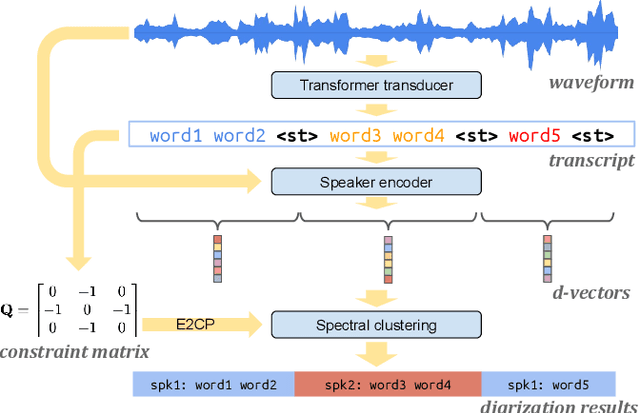
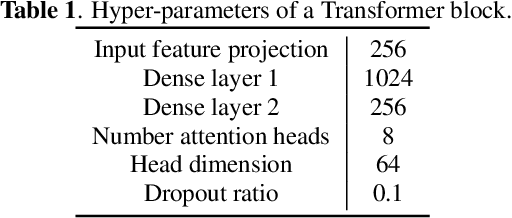


Abstract:In this paper, we present a novel speaker diarization system for streaming on-device applications. In this system, we use a transformer transducer to detect the speaker turns, represent each speaker turn by a speaker embedding, then cluster these embeddings with constraints from the detected speaker turns. Compared with conventional clustering-based diarization systems, our system largely reduces the computational cost of clustering due to the sparsity of speaker turns. Unlike other supervised speaker diarization systems which require annotations of time-stamped speaker labels for training, our system only requires including speaker turn tokens during the transcribing process, which largely reduces the human efforts involved in data collection.
Reducing Streaming ASR Model Delay with Self Alignment
May 06, 2021

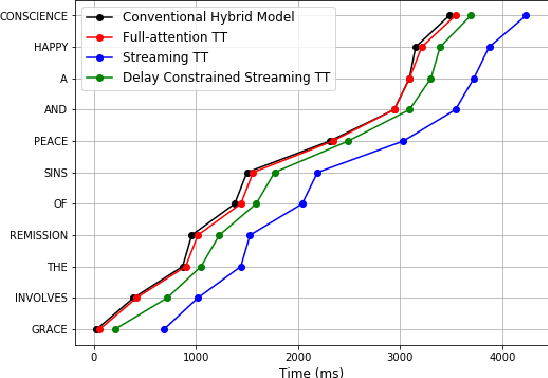
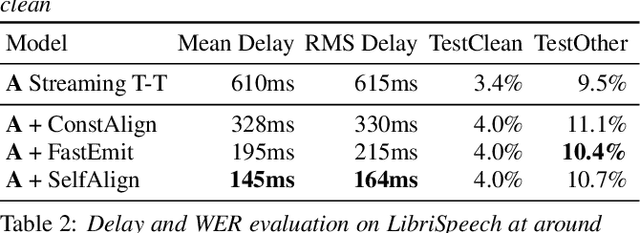
Abstract:Reducing prediction delay for streaming end-to-end ASR models with minimal performance regression is a challenging problem. Constrained alignment is a well-known existing approach that penalizes predicted word boundaries using external low-latency acoustic models. On the contrary, recently proposed FastEmit is a sequence-level delay regularization scheme encouraging vocabulary tokens over blanks without any reference alignments. Although all these schemes are successful in reducing delay, ASR word error rate (WER) often severely degrades after applying these delay constraining schemes. In this paper, we propose a novel delay constraining method, named self alignment. Self alignment does not require external alignment models. Instead, it utilizes Viterbi forced-alignments from the trained model to find the lower latency alignment direction. From LibriSpeech evaluation, self alignment outperformed existing schemes: 25% and 56% less delay compared to FastEmit and constrained alignment at the similar word error rate. For Voice Search evaluation,12% and 25% delay reductions were achieved compared to FastEmit and constrained alignment with more than 2% WER improvements.
Transformer Transducer: One Model Unifying Streaming and Non-streaming Speech Recognition
Oct 07, 2020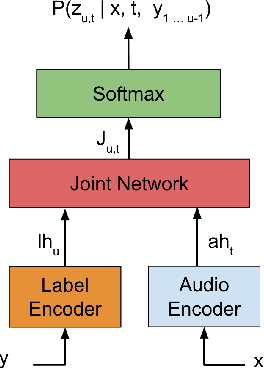

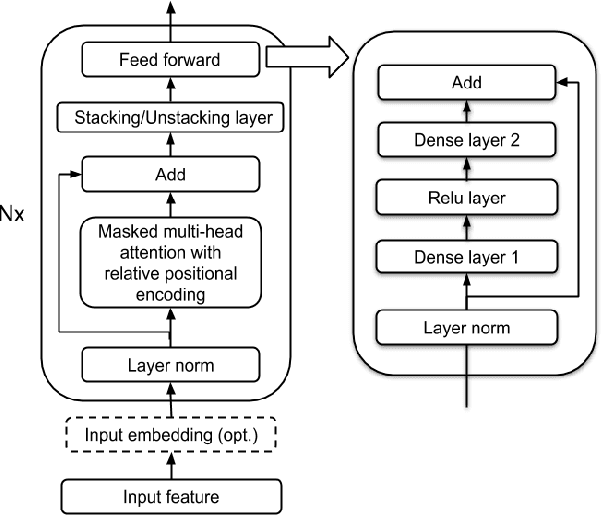
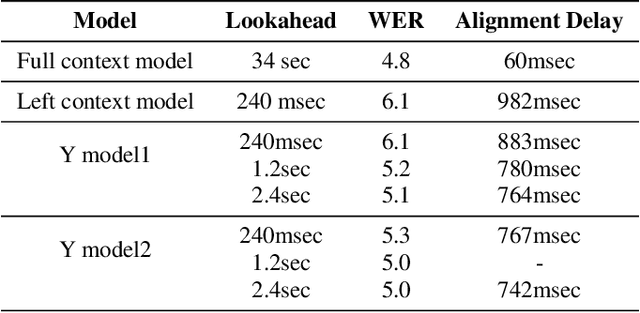
Abstract:In this paper we present a Transformer-Transducer model architecture and a training technique to unify streaming and non-streaming speech recognition models into one model. The model is composed of a stack of transformer layers for audio encoding with no lookahead or right context and an additional stack of transformer layers on top trained with variable right context. In inference time, the context length for the variable context layers can be changed to trade off the latency and the accuracy of the model. We also show that we can run this model in a Y-model architecture with the top layers running in parallel in low latency and high latency modes. This allows us to have streaming speech recognition results with limited latency and delayed speech recognition results with large improvements in accuracy (20% relative improvement for voice-search task). We show that with limited right context (1-2 seconds of audio) and small additional latency (50-100 milliseconds) at the end of decoding, we can achieve similar accuracy with models using unlimited audio right context. We also present optimizations for audio and label encoders to speed up the inference in streaming and non-streaming speech decoding.
Transformer Transducer: A Streamable Speech Recognition Model with Transformer Encoders and RNN-T Loss
Feb 14, 2020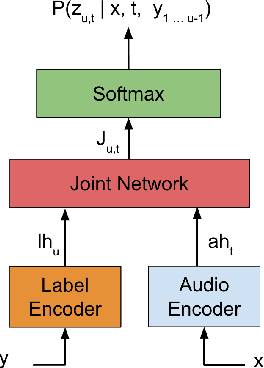
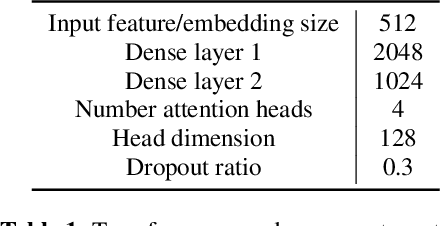

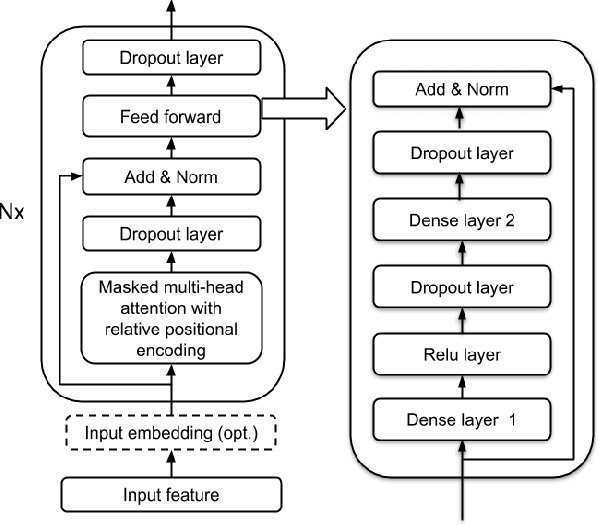
Abstract:In this paper we present an end-to-end speech recognition model with Transformer encoders that can be used in a streaming speech recognition system. Transformer computation blocks based on self-attention are used to encode both audio and label sequences independently. The activations from both audio and label encoders are combined with a feed-forward layer to compute a probability distribution over the label space for every combination of acoustic frame position and label history. This is similar to the Recurrent Neural Network Transducer (RNN-T) model, which uses RNNs for information encoding instead of Transformer encoders. The model is trained with the RNN-T loss well-suited to streaming decoding. We present results on the LibriSpeech dataset showing that limiting the left context for self-attention in the Transformer layers makes decoding computationally tractable for streaming, with only a slight degradation in accuracy. We also show that the full attention version of our model beats the-state-of-the art accuracy on the LibriSpeech benchmarks. Our results also show that we can bridge the gap between full attention and limited attention versions of our model by attending to a limited number of future frames.
UAV Control in Close Proximities - Ceiling Effect on Battery Lifetime
Dec 31, 2018
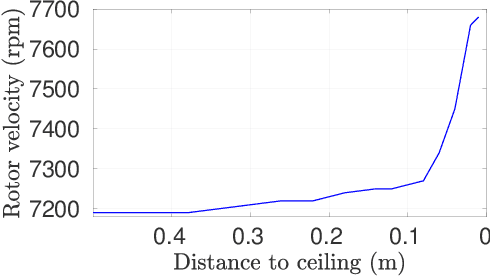
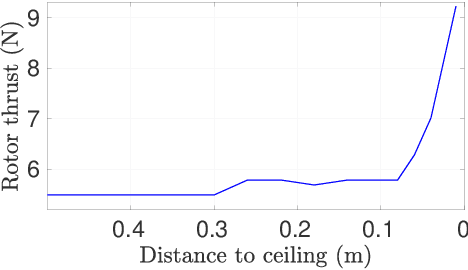
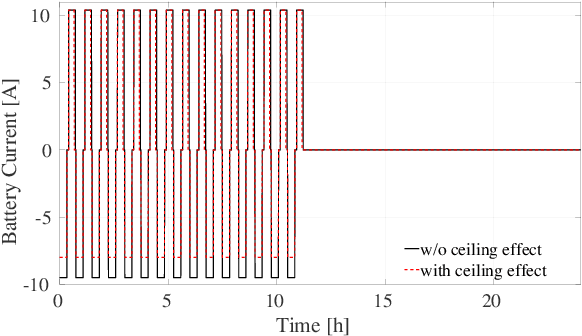
Abstract:With the recent developments in the unmanned aerial vehicles (UAV), it is expected them to interact and collaborate with their surrounding objects, other robots and people in order to wisely plan and execute particular tasks. Although these interaction operations are inherently challenging as compared to free-flight missions, they might bring diverse advantages. One of them is their basic aerodynamic interaction during the flight in close proximities which can result in a reduction of the controller effort. In this study, by collecting real-time data, we have observed that the current drawn by the battery can be decreased while flying very close to the surroundings with the help of the ceiling effect. For the first time, this phenomenon is analyzed in terms of battery lifetime degradation by using a simple full equivalent cycle counting method. Results show that cycling related effect on battery degradation can be reduced by a 15.77% if the UAV can utilize ceiling effect.
Toward domain-invariant speech recognition via large scale training
Aug 16, 2018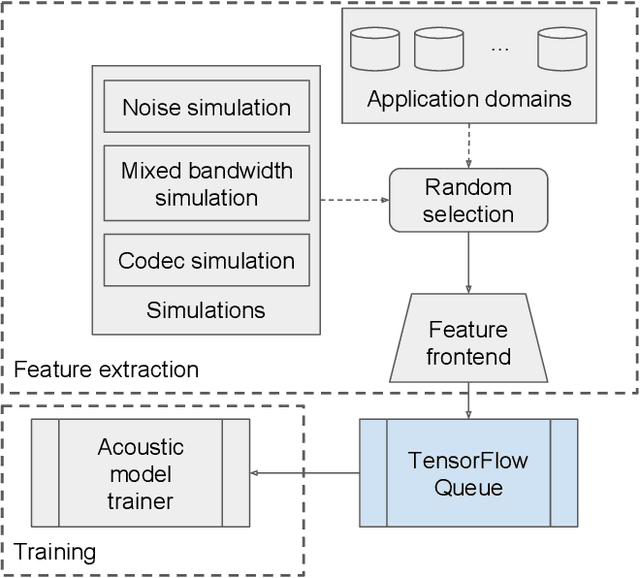
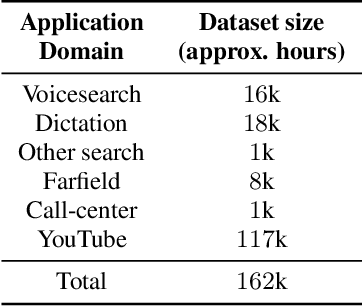
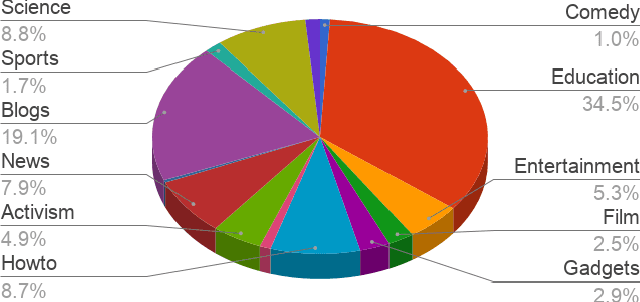
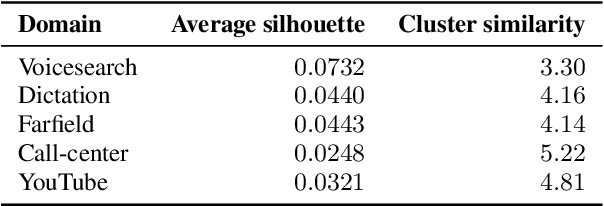
Abstract:Current state-of-the-art automatic speech recognition systems are trained to work in specific `domains', defined based on factors like application, sampling rate and codec. When such recognizers are used in conditions that do not match the training domain, performance significantly drops. This work explores the idea of building a single domain-invariant model for varied use-cases by combining large scale training data from multiple application domains. Our final system is trained using 162,000 hours of speech. Additionally, each utterance is artificially distorted during training to simulate effects like background noise, codec distortion, and sampling rates. Our results show that, even at such a scale, a model thus trained works almost as well as those fine-tuned to specific subsets: A single model can be robust to multiple application domains, and variations like codecs and noise. More importantly, such models generalize better to unseen conditions and allow for rapid adaptation -- we show that by using as little as 10 hours of data from a new domain, an adapted domain-invariant model can match performance of a domain-specific model trained from scratch using 70 times as much data. We also highlight some of the limitations of such models and areas that need addressing in future work.
Speech recognition for medical conversations
Jun 20, 2018
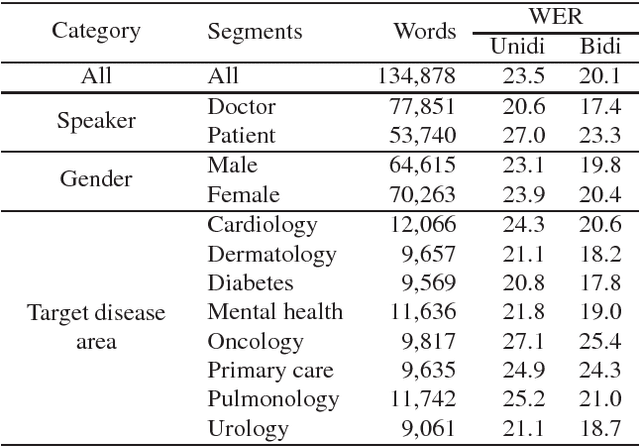
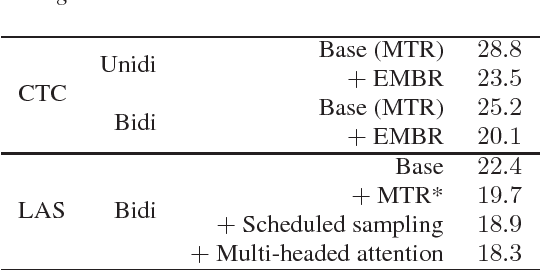
Abstract:In this work we explored building automatic speech recognition models for transcribing doctor patient conversation. We collected a large scale dataset of clinical conversations ($14,000$ hr), designed the task to represent the real word scenario, and explored several alignment approaches to iteratively improve data quality. We explored both CTC and LAS systems for building speech recognition models. The LAS was more resilient to noisy data and CTC required more data clean up. A detailed analysis is provided for understanding the performance for clinical tasks. Our analysis showed the speech recognition models performed well on important medical utterances, while errors occurred in causal conversations. Overall we believe the resulting models can provide reasonable quality in practice.
 Add to Chrome
Add to Chrome Add to Firefox
Add to Firefox Add to Edge
Add to Edge